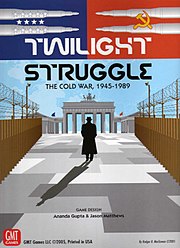Twilight Struggle

Twilight Struggle
|
|
| Designer(s) | Ananda Gupta Jason Matthews |
|---|---|
| Illustrator(s) | Viktor Csete Rodger B. MacGowan Guillaume Ries Mark Simonitch |
| Publisher(s) | GMT Games |
| Publication date | 2005 |
| Players | 2 |
| Age range | 13 and up |
| Setup time | 5–15 minutes |
| Playing time | 3 hours |
| Random chance | Medium (Dice, Cards) |
| Skill(s) required |
Strategy Card Management |
Twilight Struggle: The Cold War, 1945–1989 is a card-driven strategy game for two players, with its theme taken from the Cold War. One player plays the United States (US), and the other plays the Soviet Union (USSR). The game takes its title from John F. Kennedy's inaugural address:
"Now the trumpet summons us again, not as a call to bear arms, though arms we need; not as a call to battle, though embattled we are – but a call to bear the burden of a long twilight struggle..."
Twilight Struggle was the highest-ranked game on BoardGameGeek from December 2010 to January 2016. As of November 2016, it's ranked third.
The board is a map of the world, separated into six regions: Europe, Asia, the Middle East, Africa, Central America and South America. One player plays as the US and the other, as the USSR. Many countries are marked on the map and are connected by lines indicating their adjacency. The most important countries are marked as ‘battleground countries’. There is the ‘turn track’, denoting the current turn, a ‘victory point track’, denoting the current victory point status, the ‘DEFCON track’ denoting the current level of global stability from five (total peace) to one (thermonuclear war), the ‘space race track’, denoting how advanced each player is in the space race, the ‘action round track’, denoting how many cards are left to be played in the turn, and the ‘military operations track’, denoting how militaristic each player has been in the turn. The game is separated into ten turns which roughly cover the Cold War from 1945 to 1989. Turn One to Turn Three are the ‘Early War’, Turn Four to Turn Seven are the ‘Mid War’, and Turn Eight to Turn Ten are the ‘Late War’.
The victory point track ranges from +20 (US) to -20 (USSR), and starts on 0. As such, when the US receives one victory point, it can also be interpreted as the USSR losing one victory point, and vice versa. Throughout the game, a player can win by any of the following:
If neither player has won by the end of Turn Ten, each region is scored and this, coupled with the victory point track, determines the winner.
...
Wikipedia
